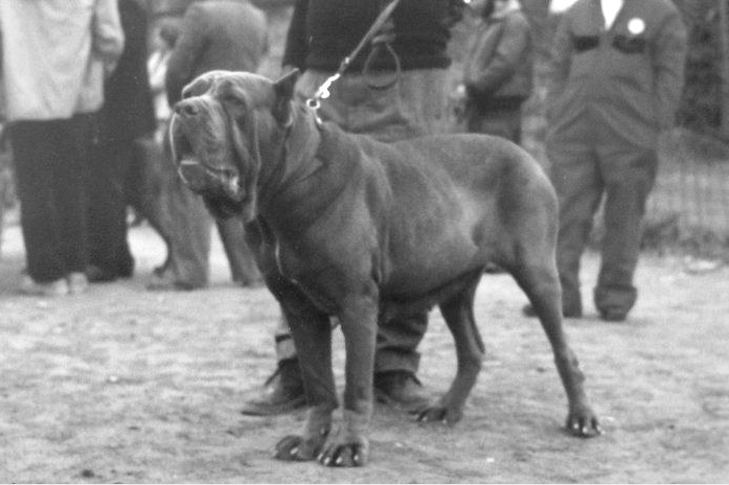Hello ladies and gents this is the Viking telling you that today we are talking about
Neapolitan Mastiff History: Get to Know the Giant, Italian Guard Dog
You don’t have to speak a word of Italian to understand opera: With a universality that transcends spoken word, its arias plunge a listener into the depths of our most primal human emotions – love and hate, jealousy and revenge.
You also don’t need to know anything about dogs to register the similarly strong emotions evoked by the sight of a Neapolitan Mastiff: From its thick, rope-like facial wrinkles to its tree-trunk-sized limbs, this is a dog of unadulterated power and primitivism. In his elastic, lumbering gait, which belongs more to a big cat than a mere canine, there is a sheer bestiality that summons archetypes older than civilization itself.
Described as the most operatic of all the dog breeds, the Neapolitan Mastiff lays claim to the heritage of the famous Molosser dog. That prized canine from ancient Greece was massive in size, with a ferocity to match, and acquired a reputation for striking awe that has endured for millennia. In truth, virtually every heavy-boned, thick-skinned, mastiff-type breed claims to descend from this peerless defender. The difference is, in the case of the Neapolitan Mastiff, that might actually be true.
The Molosser arrived in ancient Rome thanks to the expansiveness of Roman culture and the value placed on quality animals, not least of all dogs. The Romans were unapologetic collectors of unusual creatures from the farthest reaches of their empire, to say nothing of skillful dog breeders who produced specific types for different tasks, from coursing to fighting to tracking. Mentioned by a number of classical Roman writers, from Horace to Virgil, the Molossers were believed to have accompanied the Roman legionnaires as war dogs, showcasing their fighting skills in venues as spectacular as the Coliseum.
Like all great empires, Rome eventually fell, though its grand architecture survives to this day, with crumbling temples and aqueducts providing ample fodder for the smart-phone lenses of tourists. Whether the Neapolitan Mastiff is another of the empire’s many achievements to survive for millennia is harder to decipher – and perhaps it really doesn’t matter. Even if the Neo is not a proven descendent of the Roman war dogs of old, he certainly looks the part.
The Mastino Napoletano, as he is known in his homeland, is named for Naples, two and a half hours south of the Eternal City. Sitting sentry in cobblestoned courtyards, he was a valued guardian who could be relied on to repel intruders by simply raising his heavy head from atop his massive paws. The mastino was built for short bursts of speed, with just enough range to reach anyone with ill intent and the foolhardiness to attempt to exercise it. In the countryside, the Neapolitan Mastiff guarded farm and flock with as much dedication as he did the entryway to an estate.
But the relentless push of modernity, not to mention the devastation of World War II, posed an existential threat to this living gargoyle, which has survived an altogether different kind of war in the form of deprivation and starvation, which almost led to its extinction.
In 1946, Italian dog fanciers held their first postwar dog show at the Castel dell’Ovo, or “Egg Castle,” a seaside fortress on the Gulf of Naples. Eight “cani da presa,” or “catch dogs,” as Neos were known, were exhibited there, ranging in color from blue to black to brindle to gray.
While the judges were largely unimpressed with the wrinkled, underfed dogs before them, the Swiss fancier and journalist Piero Scanziani was smitten by one dog in particular. Known as “Guaglione” – which means “kid” or “guy” in the Neapolitan dialect – the “blue, mighty” dog evoked for Scanziani the ancient Molosser, staring at him “from this height of centuries past.”
Scanziani eventually acquired Guaglione, renting space at Rome’s zoo for his breeding program, which focused on accentuating the wrinkles that Guaglione admittedly did not have in abundance. Nonetheless, Guaglione became the first registered Neapolitan Mastiff and the breed’s first Italian champion, and served as the model for the inaugural breed standard.
Only a handful of years later, the Neapolitan Mastiff took a stratospheric leap forward with the arrival of Mario Querci. A textile maker from Tuscany, Querci applied his knowledge of how fabric drapes to standardize the breed’s definitive facial wrinkles, mandating the folds that fall from the outside of the eyelid to the dewlap at the throat, as well as from the lower lids to the outer edges of the lips. Querci acquired very rustic breeding stock from Naples – the so-called “zaccaro” type dog, which was heavy in bone but low on leg – and added a degree of elegance and soundness. The apex of his breeding program was arguably Caligola di Ponzano, who won the World Dog Show in Valencia, Spain, in 1992, besting some 6,600 dogs of all breeds.
And as always have a chilled day from the Viking

Comments
Post a Comment